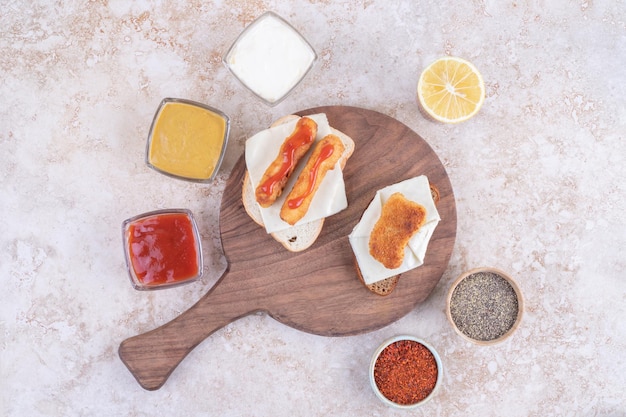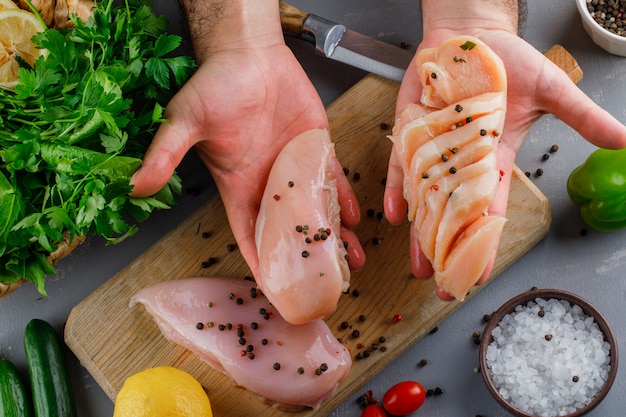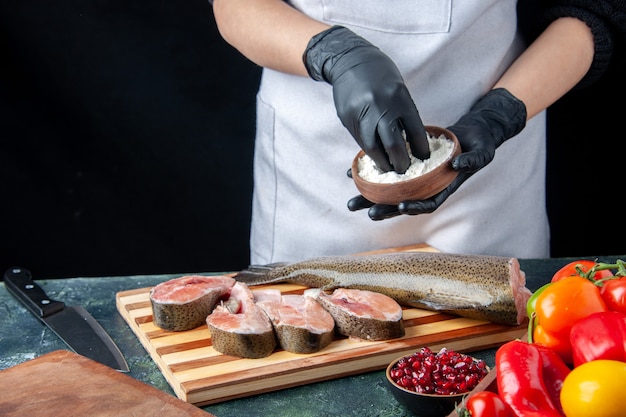frozen shrimp is a kitchen staple, always there for a quick and delicious meal. But sometimes, the thought of cooking it can feel a bit daunting, especially if you're not sure how to get it right. Fear not! cooking frozen shrimp is surprisingly simple, and with a few tips and tricks, you can achieve perfectly cooked, succulent, and flavorful shrimp every time.
I've been cooking shrimp for years, trying all sorts of methods and recipes, and I've learned that the key to success is understanding the basics and mastering a few key techniques. This guide will walk you through every step of the process, from thawing to cooking, offering insider tips and tricks based on my own experiences and a touch of personal opinion. So put on your apron, grab a glass of something refreshing, and let's get cooking!
Part 1: Getting to Know Your Shrimp

Why Frozen Shrimp?
Let's face it: frozen shrimp is a godsend! It's incredibly convenient, always available, affordable, and lasts for ages in the freezer. You can whip up a quick shrimp stir-fry for a weeknight dinner, toss some into your pasta for a flavour boost, or even grill them for a BBQ feast. The possibilities are truly endless!
Types of Frozen Shrimp
Frozen shrimp comes in various forms, each with its own unique characteristics. It's important to know what you're working with to choose the best type for your recipe:
- Raw Shrimp: This is the most common type and needs to be cooked thoroughly before eating. Raw shrimp are available in different sizes, from tiny "cocktail" shrimp to large "jumbo" shrimp. They can be peeled and deveined, or come with the shells on.
- Peeled and Deveined Shrimp: As the name suggests, these shrimp have had their shells and intestinal vein removed, making them ready to cook. You'll often find them frozen in a bag, usually already prepped for your convenience.
- Pre-cooked Shrimp: These have already been cooked, so they just need to be heated through. Pre-cooked shrimp are a great option for quick dishes like salads, sandwiches, or even as a topping for your favourite soup.
For this guide, we'll be focusing on cooking raw frozen shrimp, as that's the most common type. However, the tips and techniques can easily be adapted for other types of shrimp as well.
choosing the right shrimp
Selecting the right shrimp is crucial for a delicious outcome. Here's what to look for:
- Freshness: Look for shrimp that are firm and have a bright, translucent appearance. Avoid shrimp that are mushy, discoloured, or have a strong odour. Freshness is key to a great flavour and texture.
- Size: Consider the size of shrimp you need for your recipe. Small shrimp are perfect for cocktail skewers, stir-fries, or adding to soups, while larger shrimp are ideal for grilling, pan-frying, or showcasing as a main dish.
- Quality: Opt for wild-caught or sustainably farmed shrimp whenever possible. Check the packaging for labels that indicate the shrimp's origin and how it was harvested. It's important to support sustainable fishing practices and protect our oceans.
Part 2: The Art of Thawing Frozen Shrimp

Why Thawing Matters
Thawing your frozen shrimp properly is crucial for achieving juicy, tender shrimp. Imagine this: you throw a frozen shrimp straight into a hot pan. The outside cooks faster than the inside, leaving you with unevenly cooked shrimp that can be tough and rubbery. However, by thawing properly, you allow the shrimp to cook evenly, ensuring a delicious, melt-in-your-mouth texture.
Thawing Methods
Here are the most common and effective methods for thawing your frozen shrimp:
- Refrigerator Thawing: This is the most recommended method for ensuring a gentle thaw. Transfer your frozen shrimp from the freezer to the refrigerator for about 8-12 hours. The gradual thawing process prevents the shrimp from losing moisture and keeps them tender.
- Cold water bath: For a quicker thaw, place the shrimp in a sealed bag and submerge it in a bowl of cold water. Change the water every 30 minutes to ensure it stays cold. This method usually takes around 30-45 minutes.
- Microwave: The microwave offers a quick option, but use it with caution. The defrost setting on your microwave is the safest bet. This method takes about 2-3 minutes. However, it can lead to uneven thawing and might make the shrimp slightly rubbery.
Important Note: Once thawed, do not refreeze your shrimp. It's best to cook them immediately for the best flavour and texture.
Part 3: Prepping Your Shrimp for Cooking

Cleaning and Deveining
Unless you've purchased pre-peeled and deveined shrimp, you'll need to give them a quick clean-up before cooking. This involves removing the shells and the intestinal vein, also known as the "vein".
Here's a step-by-step guide:
- Remove the Shells: Use your fingers to gently peel off the shell of each shrimp. For larger shrimp, you can use a sharp knife to make a slit along the back of the shrimp and easily peel off the shell.
- Deveining: The dark vein running along the back of the shrimp can have a slightly bitter taste. To remove it, make a small slit along the back of the shrimp and gently pull out the vein with your fingers or a small knife. You can also use a toothpick to gently lift it out.
- Rinse: After cleaning, rinse the shrimp thoroughly under cold water and pat them dry with paper towels. This will remove any leftover debris and help prevent sticking during cooking.
Marination Magic
Marinating your shrimp is like adding a touch of magic to your dish. It enhances the flavour and adds a whole new dimension to your meal. There are endless possibilities when it comes to marinades, but here are a few of my personal favourites:
- Lemon and Herb: Combine lemon juice, olive oil, chopped fresh herbs like parsley, oregano, or thyme, salt, and pepper in a bowl. Let the shrimp marinate for 15-30 minutes. This marinade adds a bright, zesty flavour.
- Garlic and Chili: Mix minced garlic, olive oil, red pepper flakes, salt, and pepper. Marinate the shrimp for 30-60 minutes for a spicy kick. This marinade is perfect for those who love a bit of heat.
- Soy and Ginger: Whisk together soy sauce, grated ginger, honey, sesame oil, and garlic. Let the shrimp marinate for at least 30 minutes. This marinade offers a sweet, savory flavour with a touch of ginger spice.
Remember, marination doesn't just enhance flavour; it also helps to keep the shrimp moist and tender during cooking.
Part 4: Mastering the Art of Cooking Frozen Shrimp
Now that your shrimp are prepped and ready, it's time to cook them! Here are some of the most popular and effective methods:
Pan-Frying: A Quick and Delicious Classic
Pan-frying is a classic method that's quick, easy, and produces beautifully browned shrimp. Here's how to do it:
- Heat a Pan: Heat a large skillet or frying pan over medium heat. Add a tablespoon or two of olive oil or butter.
- Sear the Shrimp: When the oil is shimmering, add the shrimp in a single layer. Don't overcrowd the pan, or they won't cook evenly. Cook for about 2-3 minutes per side, or until they are pink and opaque.
- Season: Season the shrimp with salt, pepper, and any other desired spices. You can also add a squeeze of lemon juice or a sprinkle of fresh herbs for extra flavour.
Tips: For extra crispy shrimp, pat them dry with a paper towel before pan-frying. If you're cooking a large batch, fry the shrimp in batches to avoid overcrowding the pan.
Grilling: Adding a Smoky Flavour
Grilling shrimp brings a smoky, chargrilled flavour that's simply irresistible. To grill shrimp, follow these steps:
- Preheat the Grill: Preheat your grill to medium-high heat.
- Prepare the Shrimp: Thread the shrimp onto skewers or place them directly on the grill grate. Brush them with olive oil, lemon juice, and seasonings.
- Grill: Cook for 2-3 minutes per side, or until pink and opaque.
Tips: For extra flavour, try grilling the shrimp with wooden skewers soaked in water. To prevent the shrimp from sticking, oil the grill grates lightly.
Baking: A Hands-Off Approach
Baking shrimp is a great option for a hands-off approach, perfect for when you want to focus on other parts of your meal. Here's how to bake shrimp:
- Preheat the Oven: Preheat your oven to 400°F (200°C).
- Prepare a Baking Sheet: Line a baking sheet with parchment paper or foil.
- Prepare the Shrimp: Toss the shrimp with olive oil, lemon juice, garlic, and any desired spices.
- Bake: Spread the shrimp in a single layer on the baking sheet. Bake for 8-10 minutes, or until pink and opaque.
Tips: You can also bake shrimp with other vegetables for a complete meal. To add a touch of sweetness, drizzle some honey or maple syrup over the shrimp before baking.
Boiling: A Simple and Quick Method
Boiling is a simple way to cook shrimp quickly. Here's how to do it:
- Bring Water to a Boil: Fill a large pot with water and bring it to a rolling boil.
- Add Shrimp: Gently add the shrimp to the boiling water.
- Cook: Cook for 2-3 minutes, or until pink and opaque.
- Remove and Cool: Remove the shrimp from the boiling water and immediately place them in a bowl of ice water to stop the cooking process and prevent overcooking.
Tips: Add a tablespoon of salt to the water for better flavour. You can also add herbs like bay leaves or parsley to the boiling water for a hint of additional flavour.
Part 5: The Signs of Perfectly Cooked Shrimp
How do you know when your shrimp are cooked to perfection? Here are a few visual and textural clues to help you determine if they're ready:
- Colour Change: The shrimp will turn from a translucent gray colour to a vibrant pink or reddish-orange.
- Firm Texture: The shrimp will become firm and opaque.
- internal temperature: The internal temperature of cooked shrimp should reach 145°F (63°C). You can use a meat thermometer to check the internal temperature.
Part 6: The Perils of Overcooking
Overcooked shrimp can be a culinary tragedy, resulting in tough, rubbery, and dry shrimp that nobody wants to eat. It's crucial to cook them just until they're opaque and firm. Here are some tips to avoid overcooking your shrimp:
- Don't Overcrowd the Pan: Make sure you have enough space in your pan or on the grill for the shrimp to cook evenly.
- Don't Cook for Too Long: Shrimp cooks quickly, so don't overcook them. Check for the signs of doneness mentioned above.
- Use a Timer: Set a timer to remind you to check on the shrimp.
- Remove from Heat When Done: As soon as the shrimp are cooked, remove them from the heat to prevent overcooking.
Part 7: Serving and Storing Your Culinary Creations
Serving Suggestions
Now that your shrimp are cooked to perfection, it's time to enjoy them! You can serve them in countless ways, but here are a few ideas to inspire your culinary creativity:
- Seafood Paella: Combine cooked shrimp with rice, saffron, vegetables, and seafood broth for a Spanish-inspired dish that's both flavourful and visually stunning.
- shrimp tacos: Fill warm tortillas with grilled shrimp, shredded cabbage, salsa, and avocado for a flavourful and satisfying meal.
- Shrimp Stir-Fry: Toss cooked shrimp with your favourite vegetables and a flavorful sauce for a quick and easy weeknight meal.
- shrimp salad: Combine cooked shrimp with chopped vegetables, mayonnaise, and lemon juice for a refreshing salad that's perfect for a light lunch or a summer dinner.
- shrimp scampi: Sauté shrimp in garlic, butter, and white wine for a classic Italian dish that's both elegant and delicious.
Storing Leftovers
If you have any leftover shrimp, store them in an airtight container in the refrigerator for up to 3-4 days.
To reheat leftover shrimp, you can:
- Microwave: Heat the shrimp on a microwave-safe plate for 30-60 seconds, or until heated through.
- Pan-fry: Heat a skillet over medium heat and add the shrimp. Cook for a few minutes, or until heated through.
Important Note: Never refreeze cooked shrimp. It's best to enjoy them fresh or within a few days.
Part 8: Answering Your Questions
FAQs: Addressing Common Concerns
Here are answers to some common questions you might have about cooking frozen shrimp:
| Question | Answer |
|---|---|
| What if my shrimp are still a bit frozen in the middle? | If your shrimp are still a bit frozen in the middle, you can continue cooking them until they are fully cooked. However, it's important to watch them closely and adjust the cooking time accordingly. If they are thawed but still frozen in the centre, it is better to continue to thaw them more before cooking. |
| What if my shrimp are overcooked? | Overcooked shrimp will be tough and rubbery. Unfortunately, there's not much you can do to salvage them. It's best to avoid overcooking in the first place by following the tips mentioned in Part 6. |
| Can I cook frozen shrimp directly from the freezer? | It's not recommended to cook frozen shrimp straight from the freezer, as it can lead to uneven cooking. However, if you're in a pinch, you can cook them from frozen. You'll need to increase the cooking time by a few minutes. But be aware that they may not be as tender and juicy as thawed shrimp. |
| How long can I store frozen shrimp in the freezer? | You can store frozen shrimp in the freezer for up to 3-6 months. However, for the best quality, it's best to use them within 3 months. |
| What are some good side dishes to serve with shrimp? | There are so many delicious side dishes that pair perfectly with shrimp! Here are a few ideas:
|
Part 9: A culinary journey with Shrimp
As I mentioned earlier, I've been cooking shrimp for years, and it's been a journey of culinary exploration and discovery. I remember the first time I tried pan-frying shrimp. I was so nervous, afraid of overcooking them and making them tough. But I followed the instructions carefully, and they turned out perfectly! It was a moment of culinary triumph.
Over the years, I've experimented with different cooking methods, marinades, and recipes. I've learned from my mistakes (like the time I accidentally overcooked a whole batch of shrimp!) and celebrated my successes (like the time I made the most amazing shrimp scampi).
I've also learned that shrimp is a truly versatile ingredient. You can dress it up or down, and it always tastes delicious. And the best part is, it's so easy to cook.
So if you're looking for a quick and easy meal, or a way to impress your friends, give cooking frozen shrimp a try. You won't regret it!
Part 10: Concluding Thoughts
I hope this guide has given you the confidence to cook frozen shrimp like a pro. It's truly a simple and rewarding process.
The next time you're looking for a delicious and easy meal, grab a bag of frozen shrimp and get cooking! With a little bit of knowledge and practice, you'll be a shrimp cooking master in no time.
Don't be afraid to experiment with different flavours and recipes! There's a whole world of shrimp dishes out there just waiting to be discovered.
Happy cooking!
Everyone is watching

Perfect Rice Every Time: The Ultimate Guide to Cooking Rice
Cooking TipsAs a self-proclaimed foodie, I've always been a bit obsessed with rice. It's the foundation of countless cuisi...

Prime Rib Roast Cooking Time Chart: Per Pound Guide
Cooking TipsPrime rib roast. Just the name conjures images of lavish dinners, crackling fires, and hearty laughter. It’s ...

The Ultimate Guide to Cooking Asparagus: Tips, Techniques, and Recipes
Cooking TipsAsparagus. The mere mention of this spring delicacy conjures up images of vibrant green spears, crisp and burs...

Ultimate Guide to Cooking the Perfect Thanksgiving Turkey
Cooking TipsThanksgiving. Just the word conjures up images of overflowing tables laden with delicious food, the scent of r...

How Long to Bake Potatoes in the Oven (Perfect Every Time)
Cooking TipsBaked potatoes are a staple in my kitchen. They're incredibly versatile, delicious, and surprisingly easy to m...
